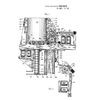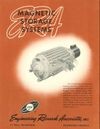1932: Tauschek patents magnetic drum storage
Gustav Tauschek patents cylinder coated with ferromagnetic material





Working at a punched-card subsidiary of IBM in Sömmerda, Germany in 1932 Austrian engineer Gustav Tauschek (1899-1945) demonstrated and patented a prototype magnetic drum storage device. Multiple stationary read and write heads each accessed tracks on a cylinder coated with ferromagnetic material that stored 500,000 bits. In 1946, Andrew Donald Booth of the University of London constructed a magnetic drum storage device, 2 in. diameter, and 2 in. long, capable of storing ten bits per inch on a nickel-plated brass drum that is on display in the London Science Museum.
As they were typically more reliable in operation than delay lines and CRTs, drum units were initially employed in immediate access memory applications as well as for storage. William C. Norris of Engineering Research Associates (ERA), Minneapolis, MN led a group, including engineers John L. Hill and Robert I. Perkins that built a magnetic drum by cementing 3M ferric oxide-coated Mylar tape to a cast aluminum cylinder for a U.S. Navy cryptographic unit in 1947. In 1950 ERA developed an 8.5 inch diameter device with 200 stationary read/write heads and a capacity of 16,384, 24-bit words for the Atlas 1 code-breaking computer that became the Univac 1101 after the company's acquisition by Remington Rand.
Computing pioneer Howard Aiken employed drum main memory on the Harvard Mark III in 1949. Other early drum memory machines included the Manchester University Mark I (1949), National Bureau of Standards SWAC (1950), and MIT Whirlwind (1951). Commercial drum memory computers included the Univac 1101 (1951), IBM 650 Magnetic Drum Calculator (1953), and English Electric DEUCE (1955). The IBM 305 RAMAC (1956) employed drum for memory and disk for storage. Drums were displaced by magnetic cores for main memory in the 1950s and by disk drives for storage in the 1960s, but remained in specialized applications into the 1980s. On these later units the magnetic media was deposited directly on the surface of the metal drum.
Contemporary Documents
- Tauschek, G. “Electromagnetic memory for numbers, and other data” German Patent DE 643,803 (Filed: July 1, 1933 Issued: April 17, 1937)
- Cohen, Arnold A. “Magnetic Drum Storage for Digital Information Processing Systems” Mathematics of Computation (No. 4, 1950) pp. 31-39
- Eichert, Jr., Edwin S. & Thomas K. Sharpless. “Magnetic Data Storage System,” U.S. Patent # 2,611,813 (Filed: May 26, 1948 Issued: Sep 23, 1952)
- "Data Processing Machine announcement" IBM Press Release (July 14, 1953)
More Information
- "Magnetic Drums" Revolution Exhibit Computer History Museum
- Rubens, Sidney M. “Data Storage on Drums” in Eric D. Daniel, C. Denis Mee, Mark H. Clark eds. Magnetic Recording: The First 100 YearsI, IEEE Press (1999) pp. 237 – 251
- Schoenherr, Steven. "History of Magnetic Recording" presented at IEEE Magnetics Society Seminar, UCSD (Nov. 5, 2002) (Retrieved on 11.5.14 from: http://www.aes.org/aeshc/docs/recording.technology.history/magnetic4.html)
- "The Magnetic Drum of Gustav Tauschek" (Retrieved on 10.23.14 from: http://history-computer.com/ModernComputer/Basis/magnetic_drum.html)
- "Workhorse of modern industry: The IBM 650" (Retrieved on 10.23.14 from: https://www-03.ibm.com/ibm/history/exhibits/650/650_intro.html)
- "Information Technology Pioneers. 2. Drum Memories" (Retrieved on 4.6.15 from: http://vipclubmn.org/Memory.html)
- Johnson, Roger G. “Andrew D. Booth – Britain’s Other ‘Fourth Man’” IFIP International Federation for Information Processing AICT 325 (2010) pp: 26-37
Oral Histories
- "Kilburn, Tom (University of Manchester) interview by C. R. Evans OH 024", Charles Babbage Institute (1976)
- "Davies, Donald Watts, Oral history interview with Donald W. Davies" Charles Babbage Institute (1986) (Retrieved from the University of Minnesota Digital Conservancy, http://purl.umn.edu/107241)
- "Traub, J. F. (Joseph Frederick), Oral history interview with Joseph F. Traub" Charles Babbage Institute. (1984) (Retrieved from the University of Minnesota Digital Conservancy, http://purl.umn.edu/107687)
- "Babcock, Dean Frank" Oral history interview with Dean Babcock, Charles Babbage Institute. (1986) (Retrieved from the University of Minnesota Digital Conservancy, http://purl.umn.edu/107098)
File name: 1932_Drum_v8
Rev: 11.27.15


